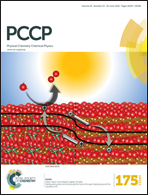Controlling reactivity by remote protonation of a basic side group in a bifunctional photoacid
Abstract
6-Hydroxy-2-naphthoic acid and its sulfonate derivatives belong to a family of bifunctional photoacids where the –OH group acts as a proton donor and the –COO− group acts as a proton acceptor. Upon electronic excitation, the –OH group becomes more acidic and the –COO− group turns more basic. Change in the ionization state of one functional group causes a change (switch) in the reactivity of the other functional group. Using picosecond time-resolved and steady state spectroscopy, we find clear evidence for an ultrafast reactivity switch caused by a diffusional proton transfer through the water solvent between the two functional groups with no evidence of a concerted proton transfer.


 Please wait while we load your content...
Please wait while we load your content...